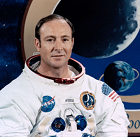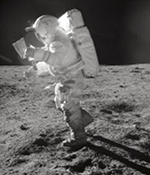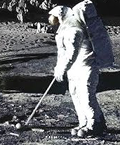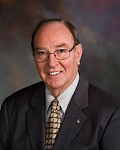Edgar Mitchell: Sixth Man on the Moon
Edgar Mitchell, a former Navy pilot and astronaut, was the sixth man to walk on the Moon. He was born on Sept. 17, 1930, in Hereford, Texas. Flight captured his interest early, and he had learned to fly by the time he was 13. His family had moved to Artesia, N.M., and he graduated from Artesia High School in 1948. 
He attended the Carnegie Institute of Technology, which is now Carnegie Mellon University, graduating with a bachelor of science degree in industrial management in 1952. Later that year, he completed basic training for the navy in San Diego. The following year, he completed training at the Officer Candidate School, in Newport, R.I., and the year after that, he completed flight training in Hutchinson, Kan. He was later assigned a patrol in Okinawa. In 1957�, he was stationed aboard aircraft carriers. Continuing his studies, he earned a second bachelor's degree, in aeronautics, from the Naval Postgraduate School and then a doctorate of science degree in aeronautics and astronautics from the Massachusetts Institute of Technology, in 1964. He achieved certification as a test pilot in 1966 and was an instructor in mathematics and navigation theory for candidates for the astronaut program. In all, he logged 5,000 hours of flight time. Mitchell joined the National Aeronautics and Space Administration (NASA) Astronaut Group 5 in 1966. He served on the Apollo 9 support crew and as the backup Lunar Module Pilot for Apollo 10. He played an important role in helping run simulations during the Apollo 13 crisis in 1970. 
Serving as the Lunar Module Pilot for Apollo 14, Mitchell walked on the Moon, setting foot not long after Alan Shepard. They were on the surface of the Moon for 33 hours and did two sessions of extravehicular activity (EVA), totaling more than nine hours. They performed experiments similar to those done by previous crews, including setting up some that would remain when they left; this crew, however, had a pull cart for carrying equipment. The cart came in handy for towing things around and having supplies ready to hand, but it became a nuisance when the astronauts had to carry it over rough terrain. One of the goals of the second EVA to to reach the rim of Cone Crater, which was 1,000 feet tall. Because the slopes of the crater were so many, Shepard and Mitchell had to turn back because of low oxygen supply in their space suits before they reached the rim; later analysis showed that they were just 100 feet away from their goal. 
Just before they got back in the Lunar Module, the astronauts engaged in a bit of sports-related research. Shepard had brought two golf balls and the head of a 6-iron golf club, which he affixed to one end of a tool that he and Mitchell had been using for soil excavation. Shepard took one swing at each golf ball (using just one hand so as not to tip over in the bulky space suit) and connected both times, sending both balls flying through the air. Mitchell took his turn, throwing a tool as if it were a javelin. They safely rendezvoused with Stuart Roosa in the Command Module and returned safely to Earth, splashing down on February 9, nine days after launch. 
Mitchell left NASA and the navy in 1972. In his later life, he appeared in documentaries, including In the Shadow of the Moon, and wrote books, including Earthrise: My Adventures as an Apollo 14 Astronaut. He later expressed an interest in consciousness research and in paranormal activities such as extrasensory perception (ESP). He also stated a firm belief in the existence of unidentified flying objects (UFOs). Mitchell died on Feb. 4, 2016. He was 85. He had married twice and had five children. |
|
Social Studies for Kids
copyright 2002–2026
David White




